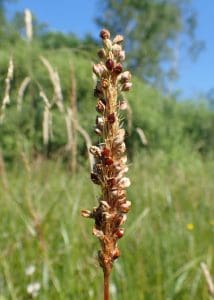Bistort / Spring / Summer / Autumn / Edible
Bistort is a common, herbaceous perennial member of the dock family. It loves damp environments and was traditionally used to make pudding in Lent.
Common Names
Bistort, Snake-root, Snakeweed, Easter-ledges, Common bistort, European bistort,
Botanical Name
Bistorta officinalis
Scientific Classification
Kingdom – Plantae
Order – Caryophyllales
Family – Polygonaceae
Physical Characteristics for Bistort
Leaves
The leaves are large, oval shaped, with heart-shaped bases. They are a bluish-green colour on the upper side and grey, tinged with purple, underneath. The leaf-stalks and blades are about 12-15 cm long. They look similar to Dock leaves but the upper part of the leafstalk is winged on Bistort.

Flowers
The flower spike can be up to 10 cm tall, the spikes look a little like bottle brushes and contain up to 150 individual flowers. The flowers themselves are bell-shaped, pink, have 5 petals and 8 stamen.

Roots
The roots are thick and twisted and produce numerous tubers, this is probably where the snake root name came from.
Habitat
It’s quite a common plant in the UK and is normally found in damp environments such as wetlands, edges of ponds and swamps and damp woodlands.
Known Hazards
None known.
Could be Confused with…
It’s quite a distinctive plant, there’s not too much that you could confuse it with really.
When in flower the only thing that would look similar is Amphibious bistort (persicaria amphibia) and this edible.
Without the flowers it does look like Dock, which is also edible, however Dock lacks the ‘wings’ on the leaf stalks.
Edible Uses
All parts of the plant are edible, cooked or raw.
It was traditionally used in Northern England to make Dock or Ledge pudding. The leaves were mixed together with oatmeal, nettles, onion, and seasoning to taste, formed into patties and fried with bacon. It was traditionally served in Lent or at Easter time.
The roots were traditionally eaten in Russia and other parts of Eastern Europe as a starchy alternative to potatoes.
Notes on Herbal Uses
Bistort root is one of the strongest astringent medicines in the vegetable kingdom and can be used to treat external or internal wounds.
It can also be used to treat diarrhoea, dysentery, and all bowel complaints.
It is also supposedly great for treating haemorrhoids.

Extra notes from the Foragers
Each year in the Yorkshire town of Mytholmroyd, the World Dock Pudding Championships are held. Competitors have to enter a full cooked breakfast featuring Dock pudding.
The name Bistort comes again from its roots, bis meaning twice and tort meaning twisted.
References:
more from calderdale on this species and the world dock championships









